The DJI Mini 3 Pro versus Autel Evo Nano+ specs: Which ultra-light drone reigns supreme? This comprehensive comparison by CARDIAGTECH.NET helps you decide which drone best suits your needs, examining design, speed, camera capabilities, and more. Dive in to discover which professional ultra-light drone provides the best value and performance. Explore key features and performance metrics to make an informed decision.
1. Unveiling the Design Differences
Autel made a splash in late 2021, around the time DJI wanted to keep the limelight on their Mavic 3 launch when it announced their Nano series, an ultra-light drone with collision sensors. This was a detail that the DJI Mini 2 lacked.
| Feature | DJI Mini 3 Pro | Autel EVO Nano+ |
|---|---|---|
| Take-Off Weight | 249g | 249g |
| Size (Unfolded) | 171 x 245 x 62mm | 170 x 215 x 55mm |
| Folded Size | 145 x 90 x 62mm | 142 x 94 x 55mm |
| Diagonal Span | 247mm | 253mm |
| Collision Sensors | Front / Back / Down | Front / Back / Down |
| Colors Available | N/A | Orange, Grey+Yellow, Grey, Red |
Autel’s drones are known for their striking orange color, reminiscent of high-visibility workwear, projecting an image of durability and reliability. However, the Nano series offers variety, including a chic grey and yellow, lighter grey with graphite trim, and a pure red. DJI’s Mini 3 Pro adopts a design similar to the Air 2S, featuring nub-like legs directly on its fuselage. In contrast, the EVO Nano mirrors the Mini 2, using front arm legs for leveling during takeoff. For optimal safety, consider using a drone landing mat, available at CARDIAGTECH.NET.
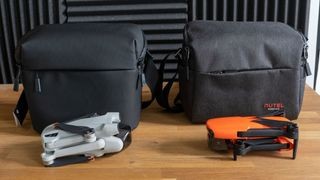 DJI Mini 3 Pro vs Autel Evo Nano Plus
DJI Mini 3 Pro vs Autel Evo Nano Plus
The placement of collision sensors differs between the two models. DJI positions front and back vision sensors in top protrusions, resembling “frog’s eyes.” Autel integrates rear sensors into the rear arm hinges, providing a clear view at any speed. Both drones feature a rear-accessed charging connector and battery, with the camera gimbal at the front. A practical advantage for Autel is the inclusion of a propeller strap and gimbal cover. The Autel batteries also feature a 4-LED test circuit for easy checking.
2. Exploring Speed and Maneuverability
When it comes to speed and maneuverability, both the DJI Mini 3 Pro and Autel EVO Nano+ offer impressive capabilities for ultra-light drones. Understanding the nuances in their performance can greatly influence your choice, depending on your specific flying needs.
| Feature | DJI Mini 3 Pro | Autel EVO Nano Plus |
|---|---|---|
| Maximum Speed | 36mph | 33.5mph |
| Wind Resistance | Level 5 Beaufort Scale | Level 5 Beaufort Scale |
| Speed Modes | Cine, Normal, Sport | Smooth, Standard, Ludicrous |
Both drones are designed to operate effectively in conditions up to Force 5 on the Beaufort scale, also known as a “Fresh Breeze.” However, in practical tests, the DJI Mini 3 Pro felt more stable and composed in windy conditions, while the Autel EVO Nano+ exhibited slightly more movement, which might affect user confidence.
The DJI Mini 3 Pro showcases impressive agility, with an ascent and descent rate of 5 m/s, indicating strong stability. Both drones come with three distinct speed modes catering to different flying scenarios. DJI labels them Cine, Normal, and Sport, while Autel uses Smooth, Standard, and Ludicrous. These modes allow pilots to adjust the drone’s responsiveness, with slower settings ideal for capturing smooth video footage and faster settings for more dynamic flying.
One advantage of the DJI Mini 3 Pro is the inclusion of a slider switch on the remote for quick speed mode adjustments, offering tactile control. The Autel remote, on the other hand, features a user-definable key, providing customization options for pilots who prefer specific functions at their fingertips.
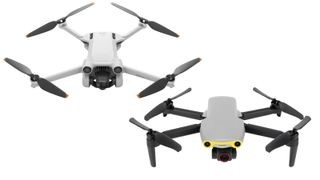 DJI Mini 3 Pro vs Autel Evo Nano Plus
DJI Mini 3 Pro vs Autel Evo Nano Plus
Collision sensing is a critical feature in both drones, enabling them to navigate around obstacles autonomously. However, when this feature is enabled, both drones tend to slow down significantly as their AI systems assess and avoid obstacles. While effective, this can be slower than a human pilot’s reactions in certain situations.
3. Understanding Battery Life
Battery life is a critical factor when choosing a drone, as it directly impacts your flying time and overall experience. Let’s compare the DJI Mini 3 Pro and Autel EVO Nano+ in terms of their battery performance.
| Feature | DJI Mini 3 Pro | Mini 3 Pro Flight Battery Plus | Autel EVO Nano+ |
|---|---|---|---|
| Battery Life (Theoretical Max) | 34 mins | 47 mins | 28 mins |
| Battery Life at Hover | 30 mins | 40 mins | 28 mins |
| Battery Capacity | 2453mAh | 3850mAh | 2250mAh |
| Battery Weight | 80.5g | 121g | 83g |
The theoretical maximum flight time is rarely indicative of real-world performance. Factors such as hovering, return-to-home time, weather conditions, and aggressive piloting significantly affect actual flight times. Expect to deduct several minutes for hovering and approximately 20% for the return-to-home function, which both drones clearly indicate via their apps and displays.
For the DJI Mini 3 Pro, an Intelligent Battery Plus version offers extended flight times. However, this increases the take-off weight above 249g. With the standard battery, you can expect about 24 minutes of useful flight time, with the Mini 3 potentially offering a couple of minutes more.
The Autel EVO Nano+ provides around 24 minutes of flight time under similar conditions. A notable advantage of Autel batteries is the built-in testers, allowing you to check battery levels quickly. DJI’s Mini series batteries require connection to the aircraft for the same information.
4. Analyzing Gimbal and Camera Performance
When it comes to camera capabilities, both the DJI Mini 3 Pro and Autel EVO Nano+ are equipped with features tailored for high-quality image and video capture. However, there are key differences that set them apart, particularly in gimbal functionality and camera features.
| Feature | DJI Mini 3 Pro | Autel EVO Nano Plus |
|---|---|---|
| Axis | 3 (pitch, roll, yaw) | 3 (pitch, roll, yaw) |
| Tilt | -135˚ to 80˚ | -125˚ to 35˚ |
| Roll | -135˚ to 45˚ | -33˚ to 34˚ |
| Pan | -30˚ to 30˚ | -25˚ to 25˚ |
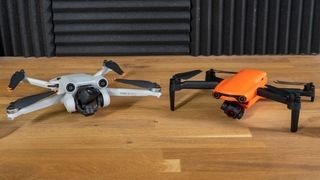 DJI Mini 3 Pro vs Autel Evo Nano Plus
DJI Mini 3 Pro vs Autel Evo Nano Plus
The DJI Mini 3 Pro has a crucial advantage on the Roll axis: the ability to rotate the camera 90˚ to portrait mode. This feature is particularly beneficial for social media content creation. The Nano+ lacks this capability, requiring images to be cropped, which results in a loss of definition.
The gimbal design of the DJI Mini 3 Pro allows greater compensation for roll pitch, while the EVO Nano’s gimbal is mounted on rubber dampers. Aggressive flying is more likely to push the EVO Nano’s gimbal to its limits compared to the Mini 3 Pro.
5. Examining Controller and Range
When it comes to controller technology and range capabilities, both the DJI Mini 3 Pro and Autel EVO Nano+ offer competitive features tailored for various operational needs. Understanding these aspects can significantly influence your flying experience.
| Feature | DJI Mini 3 Pro | Autel EVO Nano Plus |
|---|---|---|
| Technology | DJI O3 | Autel Skylink |
| Range (FCC – USA) | 12km | 10km |
| Range (CE – UK, EU) | 6km | 6km |
| Live View Quality | 1080p/30fps | 2.7k/30fps |
The communication tech in these drones provides similar practical performance. While the DJI Mini 3 Pro boasts a 12km range under FCC standards (USA), and the Autel EVO Nano+ offers 10km, both are well beyond the legal limit in many regions, such as the UK, where the limit is 0.5km.
However, the Autel EVO Nano+ has an edge in live view video quality, streaming at 2.7K when signal quality permits. This is superior to the DJI Mini 3 Pro’s 1080P. The controller design presents another interesting comparison. The Autel Nano Plus includes Autel’s newer, game-pad shaped controller, while DJI offers both their standard RC-N1 and a new controller with a built-in 700-nit display.
If you opt for the standard RC-N1 controller from DJI, keep in mind that it requires mounting a smartphone for display. The Autel controller may appear less sophisticated but is lighter. The DJI includes a handy holder for leads and control sticks, whereas Autel trusts you to keep track of these components. The DJI also has a longer battery life for its controller, an advantage if you have multiple drone batteries.
6. Evaluating Still Photo Capabilities
When evaluating the still photo capabilities of the DJI Mini 3 Pro and Autel EVO Nano+, several factors come into play, including sensor size, megapixel count, and image processing algorithms. Understanding these specifications can help you determine which drone better suits your photographic needs.
| Feature | DJI Mini 3 Pro | Autel EVO Nano Plus |
|---|---|---|
| Resolution | 48 MP | 50 MP |
| Sensor Size | 1 / 1.3 inch | 1/1.28 inch |
| ISO Range | 100-6400 | 100-6400 |
| Field of View (FOV) | 82.1˚ | 85˚ |
| Max Aperture | ƒ/1.7 | ƒ/1.9 |
| Formats | JPEG / DNG (RAW) | JPEG / DNG (RAW) |
Both drones feature impressive cameras with similar sensor sizes and megapixel counts. The DJI Mini 3 Pro has an edge in aperture, which impacts low-light performance.
 DJI Mini 3 Pro vs Mini 2
DJI Mini 3 Pro vs Mini 2
In practical terms, the DJI images tend to be sharper but exhibit more noise, especially at 48 or 50 megapixels. Both brands appear to favor 12-megapixel shooting, with DJI designating High Res as a separate mode and Autel limiting JPEG capture at full resolution.
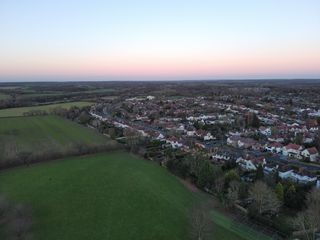 DJI Mini 3 Pro vs Autel Evo Nano Plus
DJI Mini 3 Pro vs Autel Evo Nano Plus
Autel employs a stronger sharpening effect, resulting in crisper images at normal sizes but potentially unnatural looks when closely cropped. DJI tends to preserve more unprocessed information, leading to softer edges and more noise. Both drones offer manual modes. Autel includes a shutter priority option. Both drones offer bracketing and interval shooting. The Nano+ features an HDR Imaging function. Both drones provide similar panorama capabilities.
7. Comparing Video Performance
When comparing the video performance of the DJI Mini 3 Pro and Autel EVO Nano+, several specifications and features stand out. These differences cater to varying needs in video capture, affecting overall video quality and versatility.
| Feature | DJI Mini 3 Pro | Autel EVO Nano+ |
|---|---|---|
| Resolution | 4K/60fps | 4K/30fps |
| Slow Motion | 1080P/120fps | – |
| Bitrate | 150mbps | 100 Mbps |
| Digital Zoom (4K) | 2x | 2x |
| Digital Zoom (1080P) | 4x | 16x |
The DJI Mini 3 Pro has higher frame rates with 4K/60fps, which is ideal for capturing fast-moving scenes with greater detail. It also supports slow-motion recording at 1080P/120fps, a feature not available on the Autel EVO Nano+. The higher bitrate of 150mbps on the Mini 3 Pro also allows for more data capture, resulting in better video quality with fewer compression artifacts.
DJI provides a flat color profile (D-Cinelike), while Autel offers Log. Like still images, video processing differs. The Nano+’s video is sharper due to processing. Autel offers up to 16x digital zoom compared to DJI’s 4x.
8. Highlighting Software Features
Software features play a crucial role in enhancing the user experience and expanding the creative possibilities of drones. Let’s explore and compare the software capabilities of the DJI Mini 3 Pro and Autel EVO Nano+.
AI subject tracking: The drone plots its own path to keep the subject in camera, while avoiding obstacles. Both drones are capable of this, and both can avoid obstacles, to an extent. The Nano’s Dynamic Track software is still in beta and prefers following a subject from behind, while DJI’s tracking tools are already in place and can also orbit a moving subject or track from the side. Both drone offer Hyperlapse functionality, and both also feature pre-programmed ‘QuickShots’ (automatic flight paths to capture a shareable video).
The Nano+ has an interesting extra feature; the ability to record from your phone’s microphone to the video you’re capturing – effectively to narrate (or keep audio notes). For some, it could be very useful. It also has an infuriating voice alert.
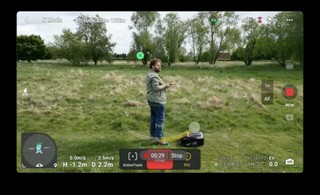 DJI Mini 3 Pro vs Autel Evo Nano Plus
DJI Mini 3 Pro vs Autel Evo Nano Plus
The Mini 3 Pro can track a subject as a POI and orbit the subject at the same time. The only risk (compared to the Mavic 3) is the drone lacks side-facing collision sensors.
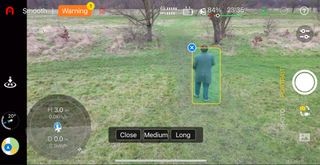 DJI Mini 3 Pro vs Autel Evo Nano Plus
DJI Mini 3 Pro vs Autel Evo Nano Plus
The Autel Nano Plus Portrait function offers use of the tracking feature to follow a moving subject, turning the drone as needed.
9. Final Verdict: Which Drone Comes Out on Top?
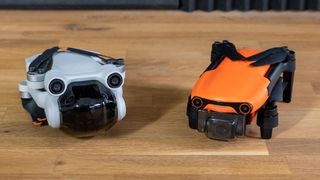 DJI Mini 3 Pro vs Autel Evo Nano Plus
DJI Mini 3 Pro vs Autel Evo Nano Plus
After a detailed comparison, the DJI Mini 3 Pro emerges as the superior choice.
The DJI Mini 3 Pro is better than the Autel Nano. The deciding factors include battery time, a slightly more reliable airframe, and variety of controller choice.
10. Resolve Your Auto Repair Challenges with CARDIAGTECH.NET
Are you a mechanic facing challenges in your daily work? Do you need tools that enhance efficiency, accuracy, and safety? CARDIAGTECH.NET is here to assist. We understand the difficulties you encounter, from physically demanding tasks to the constant need to update your skills.
We offer:
- Efficiency Boost: Reduce repair times.
- Enhanced Accuracy: Ensure precision in every task.
- Cost Savings: Minimize unnecessary expenses.
- Reputation Building: Elevate your service quality.
Ready to transform your auto repair experience? Contact us today for expert advice and tailored solutions. Reach out via WhatsApp at +1 (641) 206-8880, visit our website at CARDIAGTECH.NET, or stop by our location at 276 Reock St, City of Orange, NJ 07050, United States.
Frequently Asked Questions (FAQs)
-
What are the key differences between the DJI Mini 3 Pro and Autel EVO Nano+?
The DJI Mini 3 Pro excels with its 4K/60fps video, portrait mode, and advanced tracking, while the Autel EVO Nano+ offers a sharper image processing and a built-in battery tester. -
Which drone has better battery life?
The DJI Mini 3 Pro offers longer flight times, especially with the Intelligent Battery Plus, though this increases the drone’s weight. -
Which drone is better for photography?
Both drones offer excellent photo capabilities, but the DJI Mini 3 Pro allows more possibilities with the high res .dng option. -
Can both drones avoid obstacles?
Yes, both drones have collision sensors to navigate around obstacles, though they slow down when this feature is active. -
What is the maximum range for both drones?
The DJI Mini 3 Pro has a range of 12km (FCC) and 6km (CE), while the Autel EVO Nano+ has a range of 10km (FCC) and 6km (CE). -
Does CARDIAGTECH.NET offer tools for auto repair?
Yes, CARDIAGTECH.NET provides a range of high-quality tools designed to enhance the efficiency and accuracy of auto repair services. -
How can CARDIAGTECH.NET help improve my auto repair business?
CARDIAGTECH.NET can help boost efficiency, ensure accuracy, save costs, and enhance your service quality. -
Where is CARDIAGTECH.NET located?
CARDIAGTECH.NET is located at 276 Reock St, City of Orange, NJ 07050, United States. -
How can I contact CARDIAGTECH.NET for more information?
You can contact CARDIAGTECH.NET via WhatsApp at +1 (641) 206-8880 or visit their website at CARDIAGTECH.NET. -
What makes the DJI Mini 3 Pro better for social media content creation?
The DJI Mini 3 Pro’s ability to rotate the camera 90˚ to portrait mode is a significant advantage for creating social media content.


